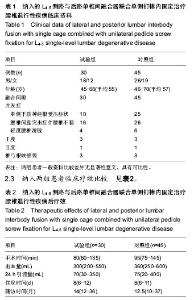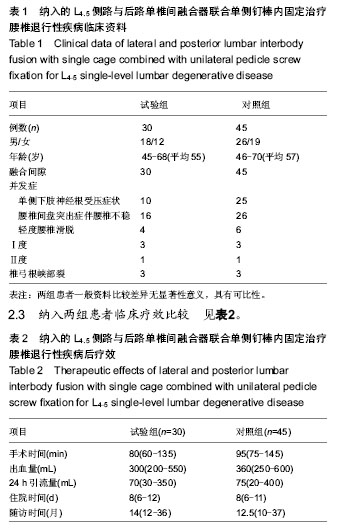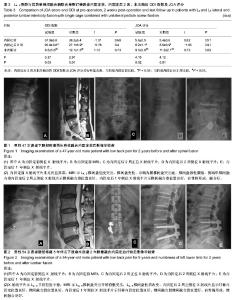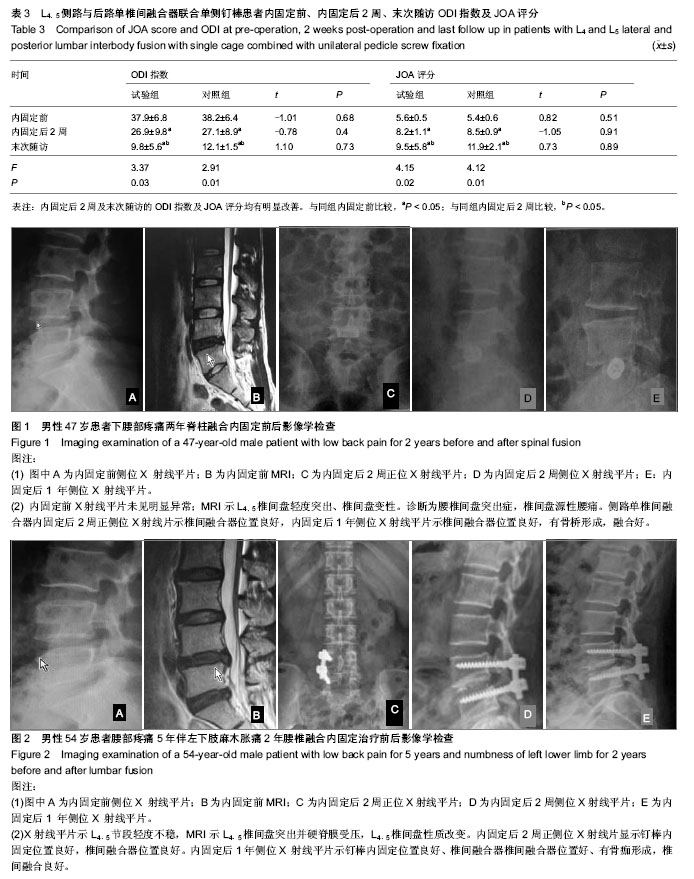| [1] 王生介,厉晓龙,夏伟才,等.髓核摘除单侧内固定椎间融合术治疗腰椎间盘突出症早期疗效[J].中国脊柱脊髓杂志,2011,21(7): 583-587.[2] Lee P, Fessler RG. Perioperative and postoperative complications of single-level minimally in vasive transforaminal lumbar interbody fusion in elderly adults. J Clin Neurosci. 2012;19(1):111-114. [3] Fischgrtund JS, The argument for instrumented decompressive posterolateral fusion for patients with degenerative spondyloisthesis and spinal stenosis. Spine. 2004; 29(2):173-174.[4] Deutsch H, Musacchio MJ Jr. Minimally invasive transforaminal lum-bar interbody fusion with unilateral pedicle screw fixation. Neurosurg Focus. 2006;20(3):E10. [5] Beringer WF, Mobasser JP. Unilateral pedicle screw instrumentation for minimally invasive transforaminal lumbar interbody fusion. Neu-rosurg Focus. 2006;20(3):E4. [6] Tuttle J, Shakir A, Choudhri HF. Paramedian approach for transfo-raminal lumbar interbody fusion with unilateral pedicle screw fixation technical note and prel iminary report on 47 cases. Neurosurg Focus. 2006;20(3):E5. [7] 蒋淳,姜小幸,冯振洲,等.单侧置钉经椎间孔椎体融合术结合经椎板的关节突螺钉治疗退行性腰椎疾病[J].中华临床医学,2010, 17(6):856-858.[8] Zhang JD, Poffyn B, Sys G,et al. Are stand-alone cages sufficient for anterior lumbar interbody fusion? Orthop Surg. 2012;4(1):11-14.[9] Miekisiak G, Kollataj M, Dobrogowski J,et al. Validation and cross-cultural adaptation of the Polish version of the Oswestry Disability Index. Spine (Phila Pa 1976). 2013;38(4):E237- E243. [10] Yone K, Sakou T, Kawauchi Y, et al. Indication of fusion for lumbar spinal stenosis in elderly patients and its significance. Spine. 1996;21(2):242-248. [11] Shah RR , Mohammed S, Saifuddin A , et al . Comparison of plain radiographs with CT scan to evaluate interbody fusion following the use of titanium interbody cages and transpedicular instrumentation.Eur Spine J.2003;12(4): 378-385. [12] Mummaneni PV, Haid RW, Rodts GE. Lumbar interbody fusion: state-of-the-art technical advances. Invited submission from the Joint Section Meeting on Disorders of the Spine and Peripheral Nerves, March 2004. J Neurosurg Spine. 2004; 1(1): 24-30. [13] Holly LT, Schwender JD, Rouben DP, et al. Minimally invasive transforaminal lumbar interbody fusion: indications, technique, and complications. Neurosurg Focus. 2006;20(3):E6. [14] 魏富鑫,刘少喻,崔尚斌,等.后路单侧椎弓根钉固定联合椎间融合术治疗退行性腰椎失稳[J].中国修复重建外科杂志,2013,27(6): 708-712.[15] Kim DY, Lee SH, Chung SK,et al. Comparison of multifidus muscle atrophy and trunk extension muscle strength: percutaneous versus open pedicle screw fixation. Spine (Phila Pa 1976).2005;30(1):123-129.[16] Kabins MB, Weintein JN, Spratt KF,et al. Isolated L4-L5 fusions using the variable screw placement system: unilateral versus bilateral. Spine(Phila Pa 1976).1992;5(1):39-49. [17] ZangJC, MaXL, WangT,etal.Unilateral versus bilateral pedicle screw fixation in lumbar spinal fusion: a meta-analysis of available evidence. Zhonghua Wai Ke Za Zhi. 2012;50(9): 848-853.[18] Xie Y, Ma H, Li H,et al. Comparative study of unilateral and bilateral pedicle screw fixation in posterior lumbar interbody fusion. Orthope-dics. 2012;35(10):e1517-1523.[19] 朱云荣,叶晓健,蒋玉权,等. 改良腰椎后路椎间植骨单侧椎弓根螺钉固定在腰椎融合手术中的应用[J]. 第二军医大学学报, 2010,31(10):1095-1099.[20] 陈家麟,茅祖斌,吴小涛. 四种经椎间孔腰椎间融合固定方式的三维有限元分析[J]. 中国组织工程研究与临床康复,2008, 12(39):7605-7609.[21] 杨群,吕德成,姜长明,等.单枚 cage 单侧椎弓根螺钉内固定术治疗退行性腰椎不稳[J].中国脊柱脊髓杂志,2009,19(12): 909-911.[22] Adamus M, Hrabalek L, Wanek T, et al, Intraoperative reversal of neuromuscular block with sugammadex or neostigmine during extreme lateral interbody fasion, a novel technique for spine surgery. J Anesth. 2011;25(5):716-720. [23] Goh JC, Wong HK, Thambyah A, et al. Influence of PLIF cage size on lumbar spine stability. Spine. 2000;25(1):35-39. [24] 朱爱国,张烽,陈向东,等. 前路腰椎椎间融合的理论研究及其治疗进展[J].中国组织工程研究,2012,16(52):9818-9822.[25] 郑忠,翁绳健,吴立忠,等. L4、5侧路单枚cage椎间融合术式的生物力学及临床研究[J].中国骨与关节损伤杂志,2011,26(1): 25-28.[26] Chang TS, Chang JH, Wang CS,et al. Evaluation of unilateral cage-instrumented fixation for lumbar spine. J Orthop Surg Res. 2010;5:86. [27] Yan DL, Pei FX, Li J,et al. Comparative study of PILF and TLIF treatment in adult degenerative spondylolisthesis. Eur Spine J. 2008;17(10):1311-1316. [28] 苗惊雷,张朝跃,詹瑞森,等.置入椎间融合器行腰椎融合后Cage移位的原因[J].中国组织工程研究与临床康复,2011,15(39): 7307-7310.[29] Rehman R, Azmatullah B, Azam F, et al, Treatment of traumatic unstable thoracolumbar junction fractures with transpedicular screw fixation. J Pak Med Assoc. 2011; 61(10): 1005-1008. [30] Bono CM, Lee CK. Critical analysis of trends in fusion for degenerative disc disease over the past 20 years: influence of technique on fusion rate and clinical outcome. Spine. 2004; 29(4):455-463. |



